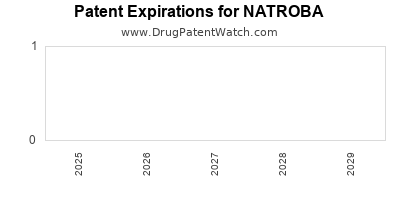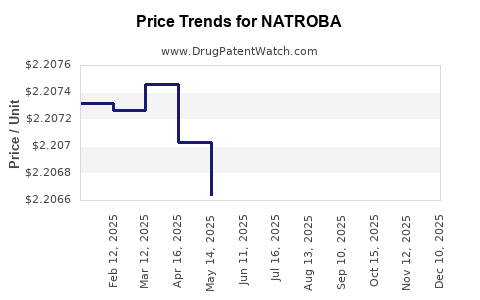NATROBA Drug Patent Profile
✉ Email this page to a colleague
When do Natroba patents expire, and what generic alternatives are available?
Natroba is a drug marketed by Cipher and is included in one NDA. There is one patent protecting this drug.
The generic ingredient in NATROBA is spinosad. There is one drug master file entry for this compound. Three suppliers are listed for this compound. Additional details are available on the spinosad profile page.
DrugPatentWatch® Generic Entry Outlook for Natroba
Natroba was eligible for patent challenges on January 18, 2015.
By analyzing the patents and regulatory protections it appears that the earliest date
for generic entry will be November 25, 2033. This may change due to patent challenges or generic licensing.
Indicators of Generic Entry
AI Deep Research
Questions you can ask:
- What is the 5 year forecast for NATROBA?
- What are the global sales for NATROBA?
- What is Average Wholesale Price for NATROBA?
Summary for NATROBA
| US Patents: | 1 |
| Applicants: | 1 |
| NDAs: | 1 |
| Finished Product Suppliers / Packagers: | 3 |
| Raw Ingredient (Bulk) Api Vendors: | 1 |
| Clinical Trials: | 4 |
| Patent Applications: | 5,529 |
| Drug Prices: | Drug price information for NATROBA |
| What excipients (inactive ingredients) are in NATROBA? | NATROBA excipients list |
| DailyMed Link: | NATROBA at DailyMed |



DrugPatentWatch® Estimated Loss of Exclusivity (LOE) Date for NATROBA
Generic Entry Date for NATROBA*:
Constraining patent/regulatory exclusivity:
NDA:
Dosage:
SUSPENSION;TOPICAL |
*The generic entry opportunity date is the latter of the last compound-claiming patent and the last regulatory exclusivity protection. Many factors can influence early or later generic entry. This date is provided as a rough estimate of generic entry potential and should not be used as an independent source.
Recent Clinical Trials for NATROBA
Identify potential brand extensions & 505(b)(2) entrants
| Sponsor | Phase |
|---|---|
| Medpace, Inc. | Phase 4 |
| STATKING Clinical Services | Phase 4 |
| Inotiv Laboratories | Phase 4 |
Pharmacology for NATROBA
| Drug Class | Pediculicide |
US Patents and Regulatory Information for NATROBA
NATROBA is protected by one US patents.
Based on analysis by DrugPatentWatch, the earliest date for a generic version of NATROBA is ⤷ Get Started Free.
This potential generic entry date is based on patent 9,895,388.
Generics may enter earlier, or later, based on new patent filings, patent extensions, patent invalidation, early generic licensing, generic entry preferences, and other factors.
| Applicant | Tradename | Generic Name | Dosage | NDA | Approval Date | TE | Type | RLD | RS | Patent No. | Patent Expiration | Product | Substance | Delist Req. | Exclusivity Expiration |
|---|---|---|---|---|---|---|---|---|---|---|---|---|---|---|---|
| Cipher | NATROBA | spinosad | SUSPENSION;TOPICAL | 022408-001 | Jan 18, 2011 | RX | Yes | Yes | 9,895,388 | ⤷ Get Started Free | ⤷ Get Started Free | ||||
| >Applicant | >Tradename | >Generic Name | >Dosage | >NDA | >Approval Date | >TE | >Type | >RLD | >RS | >Patent No. | >Patent Expiration | >Product | >Substance | >Delist Req. | >Exclusivity Expiration |
Expired US Patents for NATROBA
| Applicant | Tradename | Generic Name | Dosage | NDA | Approval Date | Patent No. | Patent Expiration |
|---|---|---|---|---|---|---|---|
| Cipher | NATROBA | spinosad | SUSPENSION;TOPICAL | 022408-001 | Jan 18, 2011 | 5,496,931 | ⤷ Get Started Free |
| Cipher | NATROBA | spinosad | SUSPENSION;TOPICAL | 022408-001 | Jan 18, 2011 | 7,030,095 | ⤷ Get Started Free |
| Cipher | NATROBA | spinosad | SUSPENSION;TOPICAL | 022408-001 | Jan 18, 2011 | 6,063,771 | ⤷ Get Started Free |
| Cipher | NATROBA | spinosad | SUSPENSION;TOPICAL | 022408-001 | Jan 18, 2011 | 6,342,482 | ⤷ Get Started Free |
| >Applicant | >Tradename | >Generic Name | >Dosage | >NDA | >Approval Date | >Patent No. | >Patent Expiration |
EU/EMA Drug Approvals for NATROBA
| Company | Drugname | Inn | Product Number / Indication | Status | Generic | Biosimilar | Orphan | Marketing Authorisation | Marketing Refusal |
|---|---|---|---|---|---|---|---|---|---|
| Elanco GmbH | Comfortis | spinosad | EMEA/V/C/002233Treatment and prevention of flea infestations (Ctenocephalides felis).The preventive effect against re-infestations is a result of the adulticidal activity and the reduction in egg production and persists for up to 4 weeks after a single administration of the product.The veterinary medicinal product can be used as part of a treatment strategy for the control of flea allergy dermatitis (FAD). | Withdrawn | no | no | no | 2011-02-11 | |
| >Company | >Drugname | >Inn | >Product Number / Indication | >Status | >Generic | >Biosimilar | >Orphan | >Marketing Authorisation | >Marketing Refusal |
International Patents for NATROBA
See the table below for patents covering NATROBA around the world.
| Country | Patent Number | Title | Estimated Expiration |
|---|---|---|---|
| China | 1382375 | ⤷ Get Started Free | |
| Germany | 68920301 | ⤷ Get Started Free | |
| Hungary | 208998 | INSECTICIDAL AND ACARICIDAL COMPOSITIONS CONTAINING MACROLIDE DERIVATIVES AS ACTIVE INGREDIENTS, PROCESS FOR PREPARING COMPOSITIONS AGAINST ECTOPARASITES AND PROCESS FOR PRODUCING THE ACTIVE INGREDIENTS | ⤷ Get Started Free |
| Eurasian Patent Organization | 003060 | СОСТАВЫ ДЛЯ БОРЬБЫ С ЧЕЛОВЕЧЕСКИМИ ВШАМИ (FORMULATIONS FOR CONTROLLING HUMAN LICE) | ⤷ Get Started Free |
| Germany | 122007000053 | ⤷ Get Started Free | |
| German Democratic Republic | 290351 | VERFAHREN ZUR HERSTELLUNG VON MAKROLID-VERBINDUNGEN | ⤷ Get Started Free |
| Australia | 750046 | ⤷ Get Started Free | |
| >Country | >Patent Number | >Title | >Estimated Expiration |
Supplementary Protection Certificates for NATROBA
| Patent Number | Supplementary Protection Certificate | SPC Country | SPC Expiration | SPC Description |
|---|---|---|---|---|
| 0375316 | C350009 | Netherlands | ⤷ Get Started Free | PRODUCT NAME: SPINOSAD, DESGEWENST IN DE VORM VAN EEN ZOUT; NATL. REGISTRATION NO/DATE: 12363 N 20020913; FIRST REGISTRATION: SE 4511 20020204 |
| 0375316 | 350009 | Netherlands | ⤷ Get Started Free | |
| 0375316 | 06C0047 | France | ⤷ Get Started Free | PRODUCT NAME: SPINOSAD; REGISTRATION NO/DATE IN FRANCE: 2060098 DU 20060628; REGISTRATION NO/DATE AT EEC: 9275/B DU 20011023 |
| 0375316 | SPC/GB02/028 | United Kingdom | ⤷ Get Started Free | PRODUCT NAME: SPINOSAD; REGISTERED: CH W 6020 20010313; UK 0714 20020227 |
| >Patent Number | >Supplementary Protection Certificate | >SPC Country | >SPC Expiration | >SPC Description |
Market Dynamics and Financial Trajectory for NATROBA
More… ↓
Make Better Decisions: Try a trial or see plans & pricing
Drugs may be covered by multiple patents or regulatory protections. All trademarks and applicant names are the property of their respective owners or licensors. Although great care is taken in the proper and correct provision of this service, thinkBiotech LLC does not accept any responsibility for possible consequences of errors or omissions in the provided data. The data presented herein is for information purposes only. There is no warranty that the data contained herein is error free. We do not provide individual investment advice. This service is not registered with any financial regulatory agency. The information we publish is educational only and based on our opinions plus our models. By using DrugPatentWatch you acknowledge that we do not provide personalized recommendations or advice. thinkBiotech performs no independent verification of facts as provided by public sources nor are attempts made to provide legal or investing advice. Any reliance on data provided herein is done solely at the discretion of the user. Users of this service are advised to seek professional advice and independent confirmation before considering acting on any of the provided information. thinkBiotech LLC reserves the right to amend, extend or withdraw any part or all of the offered service without notice.
